Last summer, Akio Kondo visited California to work and to teach bonsai. During a Bay Island Bonsai workshop, Kondo made an interesting suggestion for improving one of my pines. The tree looked great from a distance, but he quickly noticed that the tree had no interior buds. Without interior buds, the tree had no future. What to do?
I’ve been waiting a year to put his advice to the test. His suggestion was to decandle the tree in fall. Two of my trees made good candidates for the experiment. I decandled the first two weeks ago. I’m now getting to the second tree.
What’s the theory? Fall decandling is a two year process. By decandling late, “summer” buds have little time to develop. If the tree is healthy, it will produce adventitious buds in the tree’s interior.
If all goes according to plan, the tree will look silly in a few months – nothing but weak buds and old needles. Next spring won’t be much different. But as these new buds take hold, they set the stage for the following year. With a second year’s growth, the tree will regain its former vigor. So goes the theory.
Below are detailed shots of the decandling and needle-pulling process. I treated the tree like I would in spring, so the steps below apply equally to pines decandled in summer.

One down and one to go – decandling Japanese black pine bonsai
I hadn’t thought twice about the health of this pine until Kondo took a peek inside. The buds are very healthy for such a small pine.
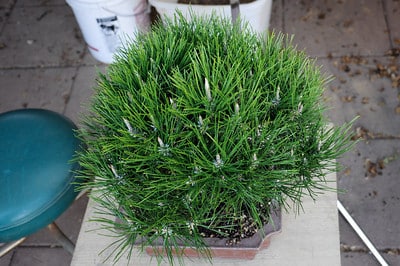
The tree looks full and healthy, right?
Looking inside revealed another story. Decandling, wiring, and selective pruning tend to stimulate back budding, but this entire tree needs new buds, and if the usual steps don’t work, the tree would require a lot of grafting.
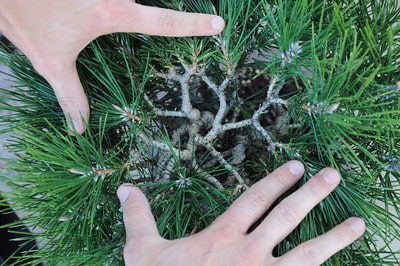
No buds inside
The lack of buds is likely the result of several years of cutback without wiring. I decandle the tree every year, but without wiring the new shoots into place, the new growth clusters together and prevents adventitious buds from sprouting.
The basic decandling process is simple: remove the spring growth just above the line of the old needles.
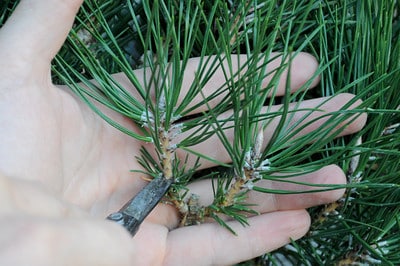
Positioning the scissors to cut the shoot
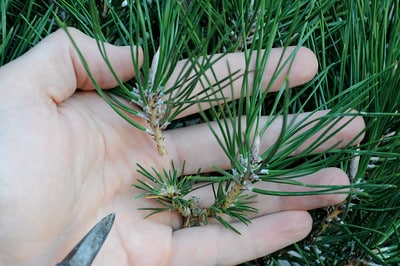
Spring shoot removed
There are, however, plenty of details. If I address the shoot with open scissors, I risk slicing last year’s needles.
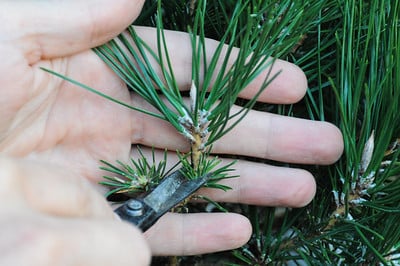
Careless scissor technique
To avoid this, I close the scissors as I address the shoot.
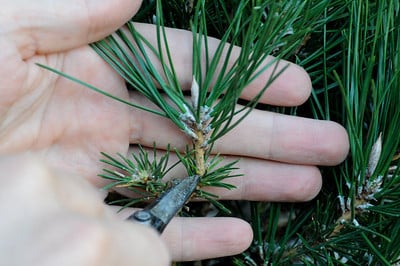
Approaching the shoot with scissors closed
I also try to make all of the cuts perpendicular to the direction of the shoot as angled cuts produce uneven growth.
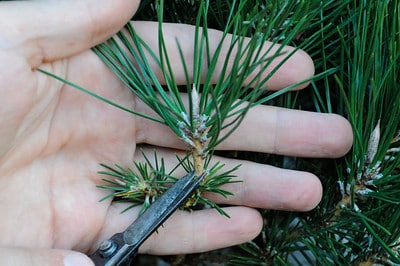
Steep cutting angles produce uneven growth
Once I line up the cut, I gently sever the shoot without jerking the scissors away.
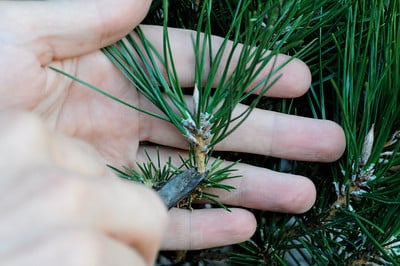
Scissors square, needles out or harm’s way; ready to cut
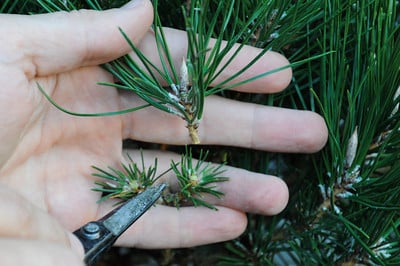
Spring shoot removed
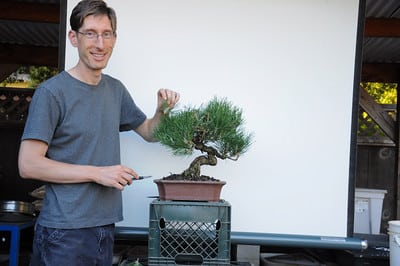
Decandling is fun!
After removing the new shoots, I removed needles from the stronger areas of the tree to promote more balanced growth next year.
I’ve been pulling needles with tweezers for years and still don’t have the speed that comes from the experience of the incessant pine work that many professionals face each fall. It’s an amazing thing to watch when it’s done well.
I try to grab each pair of needles at the base.
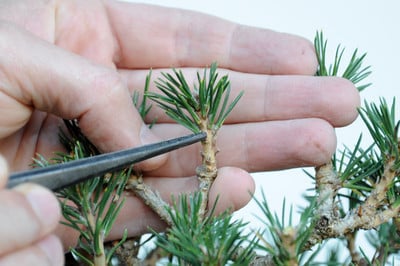
Grabbing pine needles with tweezers
If I pull the needles higher up, above the fascicle, I’ll need to go back to remove the fascicle.
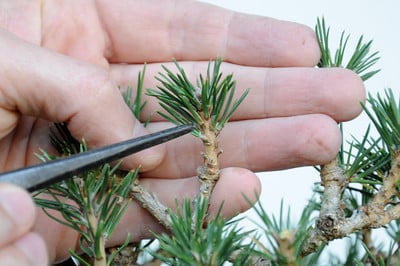
Pulling needles above the fascicle
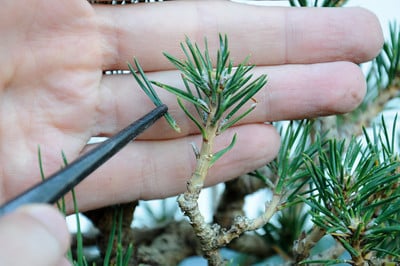
Needles removed – fascicle still in place
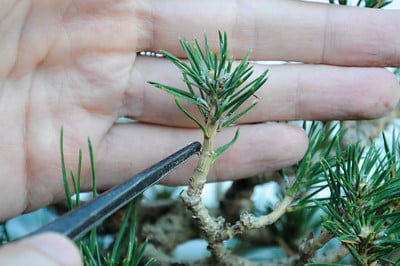
Grabbing the fascicle with tweezers
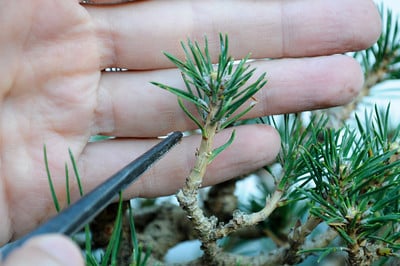
Fascicle removed
Many years ago, I asked Kondo if I should remove the bracts that sometimes grow beneath pine needles. He said yes. I noted that this could greatly increase the time it takes to complete the process. He smiled and agreed. When working for clients, professionals have to leave their trees clean. Clean trees look good and are easy to wire. I got back to work.
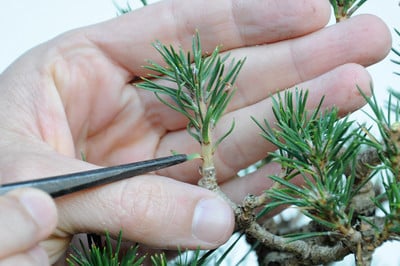
Removing a needle bract
When I finished pulling the bracts and needles, it became clear that the tree needed wiring. I’ll wait until late fall when the tree slows down a bit. In the mean time, plenty of light and air will get to the interior for the first time since last winter.
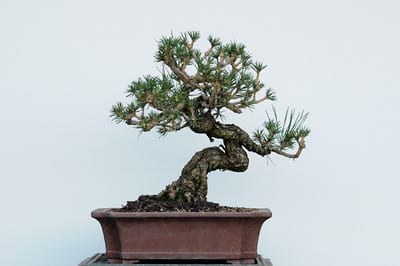
All cleaned up – ready for wiring
I’m very curious to see how the fall decandling experiment goes. Today the trees look great – and if all goes well, they’ll look good in the future too.
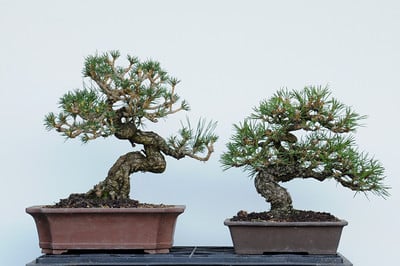
Fall decandling complete!
Subscribe to Bonsai Tonight
New Posts Delivered Every Tuesday and Friday
Fr. Tom Davis says
Thanks for sharing this!
One thing I have a question about is that when plucking the needles, if one wants back budding, the needle fascicles contain the beginnings of new buds, and if you want more inner ramification, should those be left so as to encourage new budding?
xwires says
Hi Tom – If I want new buds to appear where needles are growing I usually either cut the needles back to the fascicles or selectively pull needles. For these two pines, I need new buds where no needles are growing so I can safely remove needles and fascicles.
Kestutis says
I was just wondering – is the same treatment also applicable to other pines – eg. white pines, sylvestris (jack) pines?
k.
xwires says
Hi K – decandling by the means described here is not appropriate for white pines. I don’t know much about Jack or Scots pines, though I think the process is different for them as well. These decandling tips apply to both black and red pines.
Michael – that’s right – I simply decandled later than normal by several months. I won’t fertilize heavily through winter as the trees are somewhat dormant – another reason why I’d only attempt this after fertilizing heavily during the growing season.
Michael M says
I may have missed something here. These trees were not decandled this past spring. Is that right? The trees had a full year-plus worth of growth before this treatment. And I assume you continue with a full fertilizer treatment all the way through the year and up to next spring.
Thanks for the idea.
Jeff Lahr says
Great artcle.
Great photographer+Talented writer+Talented BOnsai artist= great blog.
Glad that I discovered this site.
Jeff Lahr
Santa Maria, CA
Mark says
You say that you expect the tree to regain vigour in two years. With summer decandling this could happen sooner. So, what’s the advantage over spring/summer decandling?
xwires says
Hi Mark – by decandling late, I hope to stimulate much more back budding than I could by decandling in spring. The tree will have to work harder over a longer period of time to regain its vigor which provides the trigger for interior bud development. From what I understand, the technique is common among a select number of professionals in Japan.
Fr. Tom Davis says
Jonas,
Is it correct thinking that by decandling in Autumn, trying to balance the growth, interior back-budding and filling in, that Spring decandling should wait until what one needs for interior growth has finished, thereby working on ramification of the whole tree and not just the outer growth?
xwires says
Hi Tom – I think of fall decandling as more of a special case technique for trees that really need the buds and are healthy enough to produce them. If the case isn’t so bad or the tree is a bit on the weak side, increasing vigor, wiring and grafting are good solutions. I’m also curious to learn how this works with older trees. I won’t likely try this until I learn more about the technique and find myself in possession of a good candidate for the process.
Dale Brock says
I have a Black Corkbark Pine that I purchased from a gentleman up Minnesota area. Moving it to Houston, TX has been a culture shock to say the least. My inexperience hasn’t helped. The needles went from 1 inch to 2 and a half. These long needles are starving out the interior from sunlight and weakening the tree. Do you have any ideas?
xwires says
Hi Dale – Texas can be a challenge for black pines. I’d suggest contacting local enthusiasts who’ve had experience with the variety. I can recommend contacting the Bonsai Smiths as they have lots of experience with black pines and deep bonsai knowledge. Finding a local club would be another good place to start.
In general, the one thing to watch closely is the tree’s vigor. If you can keep the tree healthy, then the warm weather can be great for pines as long as it is not too much for them. Pines are typically decandled fairly late in Texas – that’s one way to keep the needle growth in check. Beyond that, keeping the tree wired, if it’s healthy, and performing annual cutback can keep the tree open enough to nurture interior buds.
Jay melendez says
Jonas, I have spent countless hours studying black pine but never got it tell. I found your web site. I have a off topic question is it normal for old needles to start to turn yellow around this time year I live in north mississippi. Just want to make sure my tree is okay:
xwires says
Hi Jay – It’s normal for last year’s pine needles to turn yellow in fall. Depending on the health of the tree and the total number of needles on the tree, fall is when we usually remove old needles from vigorous areas – the change in color makes them easy to distinguish from the new ones.